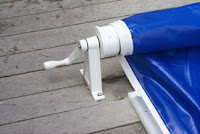
How many times have we pulled up to the drive up window and said supersize my order? I mean, after all, we are Americans and we do believe that bigger is better. Why settle for regular Fries when I can double its size for 10 cents more. Who cares if I get three times more fat and carbs. You don’t have to look any further than the auto industry to see examples of this either. Hummers, Suburban’s, Tahoe, Yukon, all bigger and better right?
Well that is until our values changed and we started caring more about fuel efficiency and saving the planet and how darn cute we look riding down the road in our Audi TT or VW, or Prius. You see we started to pay attention to fuel efficiency and realized that we could get to the same place on time and get there on 50 miles to the gallon. (Best case scenario) Saving us money, fuel and the planet all at the same time.
These same principles hold true with swimming pools and how we tend to think that supersizing our pump and filter system must be better right? Well. . .this isn’t exactly a TRUE statement. Let’s take a look and see what needs to be Supersized, What doesn’t, and Why.
New pool owners tend to think that the bigger pump... the better, the larger the filter, the better… Right? So. . .How can I have a clean pool and not spend $100 per month extra on my utility bill.
It turns out that there are three really important things that we need to think about when talking about what is the best circulation system.
1. Size the Plumbing Correctly to allow for Proper Circulation.
The first is properly sizing the plumbing that we use when our pool is being built. In this case bigger is better. I know I am already contradicting myself, but stay with me here. Staying with my Fast-food analogy, if you are drinking a coke – Which is easier and takes less effort to use? A nice big McDonalds straw or a little brown swizzle stick straw? Carry this over to your pool. . .Which do you think will allow water to flow easier with less restriction? Big Pipe. . .or Little Pipe? So in this case PIPE SIZE = bigger is better 2”, 2 1/2″, 3″ and so on. Bigger Pipe is optimum to allow maximum flow.
2. Pump Size – Not available in “Supersize” option (unless you want to pay beaucoup bucks!!) The second is the big one and still to this day is fought over by those unwilling to see the light… Pump size.
ALERT! In many sales presentations it is pushed on you, the homeowner, that“ the other guy is only putting a ¾ hpr pump but we are a 1 ½ hpr on therefore we are the better deal” Not True! In fact, guy number two may actually be running a less efficient system that will end up sucking money out of your pocket book for years to come.
Do a Little Research First! Nowadays, you need to ask the question: How many gallons per minute do I need? Instead of asking: How much horse power do I need? Did you know that in a lot of cases you can run a smaller pump for 24 hours a day for significantly cheaper than a larger pump for 8 hours a day?
“Wait a minute“,you say, “But I am only running it 8 hours a day…surely it is less money!?” Nope! it’s not, and it won’t keep your pool as clean and could cost you more than double what it should.
There are calculators, charts and guides available from several pump manufacturers that can help with choosing the right size pump and filter for your pool:
Pentair PoolJandyHaywardAll REPUTABLE pool builders and service companies are seeing the wisdom of 2 speed pumps and variable speed pumps. These pumps allow you even more control over efficiency and will return your investment in most case within 4-6 months. Not to mention you can run cool water features with them without the added operational expense.
3. DON’T forget about the Speed Bumps!
And finally, let’s make note of all the other speed bumps that get thrown in the way of your swimming pool water’s flow: Heaters, Salt Systems, Chlorinators, excessive PVC 90′s, 45′s, connectors, elbows etc… Your swimming pool builder should take all of these additional options into consideration when they calculate your hydraulics system....and properly size the pipes, filter, and pump. All systems manufacturers have maximum gpm (gallons per minute) ratings available for each piece.
When all is said and done your swimming pool should run efficiently and for less money! To find out in more detail about these topics please visit the sites links above. And always, contact any one of us at Penguin Pools! We’re here to help you with any vinyl liner, fiberglass, composite, gunite, concrete swimming pool issues. 612-225-0007




















